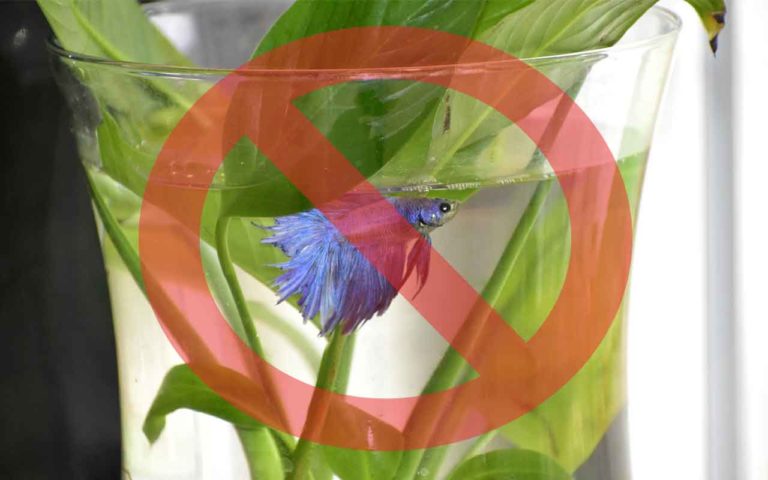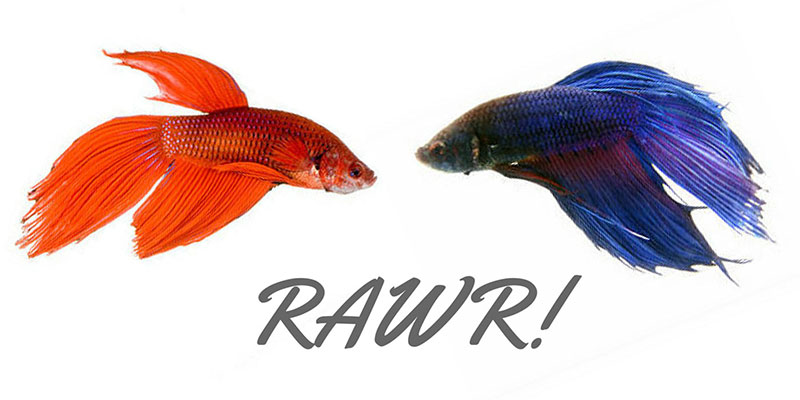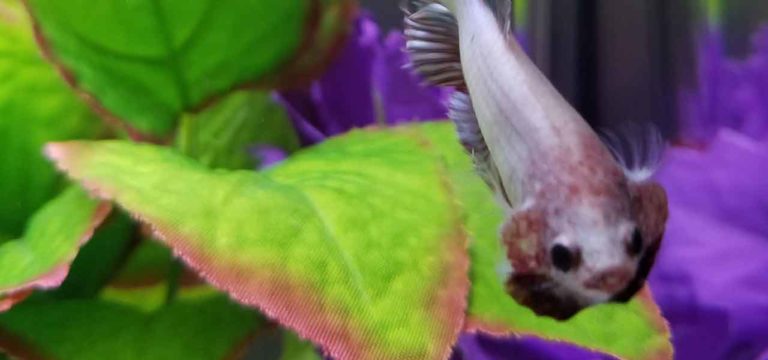Betta Fish
The betta, pronounced [bet-ta], or siamese fighting fish is a tropical freshwater fish within the gourami family. The most popular betta fish are scientifically known as Betta splendens. Popular with beginner and expert aquarists alike, bettas have been crowned as one of the most popular pet fish species in the world. Their big personalities, intelligence, and bright colorings have created a large and loyal following.
Naming: Betta, Betta splenden, Siamese Fighting Fish
Characteristics: Carnivores who live ~2-4 years
Native Location: Thailand, Cambodia, Loas, Vietnam
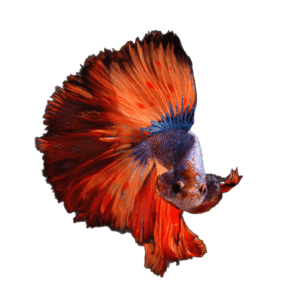
Popular Pages & Resources
Betta Care
Learn how to properly care for your betta. Plus, enjoy a free downloadable care sheet.
Betta Food
Learn the best types of food, plus how much, and how often to feed your betta fish.
Betta Illnesses
Learn how to treat a sick betta fish by identifying the most common illnesses.
The native and wild betta fish habitat includes densely vegetated rice paddies, floodplains, and still-watered canals in areas like Thailand and Cambodia. These locations experience periods of prolonged drought. The betta can survive in small volumes of low-oxygenated water (even puddles) while attempting to jump to larger bodies of water.
The betta is a labyrinth fish, which allows it to breathe atmospheric air at the water’s surface, as well as underwater through its gills. This unique ability helps the betta survive these droughts – in water that contains very little oxygen. This ability has also created rampant myths about their care.
Betta fish need to get air from the water and at the water’s surface. You should never fill a habitat to its maximum volume, and always use a cover to prevent them from jumping out of their habitat.
Can Betta Fish Live In A Fishbowl?
Yes, technically a betta fish can live in a fishbowl so long as it’s at least 2.5 gallons. Fishbowls are also ideal as temporary housing for cleanings or quarantine.
Bowls do, however, make it hard to add necessary equipment and plants for a betta fish. Bowls also do not normally come with a cover – creating an additional problem. Betta fish are great jumpers and may leap right out of an uncovered fishbowl.
Larger tanks are better for maintenance and the health of your betta. Betta fish tanks should be a minimum size of 2.5 gallons with the recommended size being 5 gallons for permanent housing.
Small habitats, like a fishbowl or vase, can lead to a lot of problems. Oxygen in the water is quickly depleted and the water’s temperature will be very hard to maintain. Cold water leads to a lethargic and stressed betta. Water quality is also a major concern in small habitats and will become toxic much faster. These conditions can quickly create health issues.
Food breaks down and betta fish produce waste, creating ammonia – which is harmful to your fish. The betta fish in the photo above is suffering from fin rot. You don’t want your betta swimming around in dirty poop water!
Bettas cannot sustain a healthy life by living in a vase and feeding off the roots of a plant either. This lack of education by owners leads to what PETA calls, “being sentenced to a dull, lonely, and slow death from starvation.” Bettas are carnivores and require protein, fiber, and other nutrients in their diet.
Why Are They Called Fighting Fish?
In the mid to late 1800’s the King of Thailand took an interest in the betta after native workers were observed collecting them in rice paddies. These locals began breeding them specifically for fighting. The King became so engrossed in the sport of betta fish fighting that he later sanctioned regular events and kept his betta victors in his quarters.
Locals in Thailand began referring to the betta as Pla Kad, or “fighting fish” because of their territorial aggression. That genetic aggression still largely exists today and has not been bred out.
Many species of fish are known for traveling in packs, called shoaling or schooling, but not the betta. Betta fish prefer to be independent both in captivity and in the wild.
In the wild, the betta has more room to be independent and can retreat safely if they encounter another betta. In close quarters, like a fish tank, this can lead to extreme aggression and territorial matches. These altercations can produce a lot of stress and potential damage or death.
Common Behaviors
Betta fish do a lot of quirky things that may leave a beginner scratching their head in confusion. Below are some common behaviors a beginner might experience when they bring their betta fish home.
Flaring
Betta fish flare their operculum, or gill cover, in an act of intimidation. It makes the betta look larger and more threatening to potential predators or other betta fish. Your betta may also do this if you approach their tank or territory quickly. If you want to see this behavior in action, try using a small mirror so he or she can see their reflection.
Bubble Nest Building
Males instinctually build bubble nests to attract a female for breeding. This can happen whether there is a female present or not. If your betta is making a bubble nest, it’s a sign they are healthy. A male will care for and protect the eggs in the bubble nest after mating.
Spitting Out Food
Bettas can be picky eaters if they don’t like what you’re serving. They show their dissatisfaction by spitting their food back out. If this happens, you’ll need to find another high-quality food source. Refusal to eat may also mean they’re full, but this is less common.
Never overfeed your betta as it can lead to a lot of health problems. Feed 2-3 pellets, 1-2 times per day. For perspective, their stomachs are roughly the size of their eye. Visit the betta fish food and feeding page for more information.
Fin Clamping
Clamping is one of the major signs of stress or illness. This is commonly related to abrupt changes in water quality or temperature. Your bettas fins will be tucked close to their body instead of fanned out. If you think your betta is sick, visit the betta illness and diseases page to help diagnose and treat a variety of common illnesses.
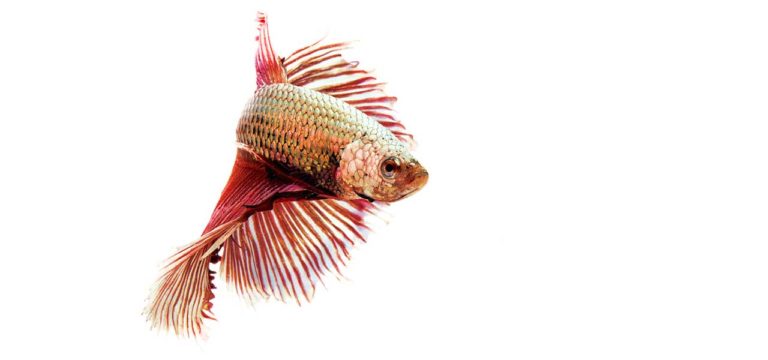
Did you know?
Betta fish have really sharp teeth and an incredibly strong jaw but are unable to pierce human skin.
Betta splendens didn’t come to the U.S. until 1910.
Horizontal lines alongside the body of a male or female are an indication of stress.
Betta fish inflate or deflate their internal organ called the swim bladder to control their depth in the water. Overfeeding can cause swim bladder disorder.
Types of Betta Fish
The most common betta fish in pet stores like Petco and PetSmart are Betta splendens. They are quite different in color and size, compared to their wild counterparts. Wild betta fish have smaller fins and are dull green or brown.
Betta splendens have been selectively bred in many different tail types and every color combination you can think of. The most common tail types in the U.S. are the veiltail and crowntail, with the most common color being red or blue.
Males vs. Females
Males and females look very different from one another. Males have longer fins and typically possess brighter colorings. This is why male betta fish are higher in demand.
Unlike males, female bettas can live peacefully together in the same tank in what is called a Sorority. A sorority is comprised of 5 or more female betta fish cohabitating.
The minimum size habitat for a sorority is 10 gallons. Caution should still be exercised when initially setting one up. If one female seems to be an aggressor, she may need to be removed and transported to a new tank by herself.
For more information on how to identify the sex of a betta, and to read the full list of differences between males and females, visit the betta fish anatomy page.
Betta Fish Make Great Pets
Whether a first pet to teach your child responsibility, your sixth pet addition to the family, or your dorm room companion, a betta fish will charm any space.
Did you know betta fish and other tropical fish and aquariums can reduce stress? Coming home from a long day at school or work and watching a betta fish elegantly explore their habitat is very soothing.
Bettas are relatively inexpensive to purchase, set up, and maintain compared to many other pets. They take up a small footprint and their food lasts for ages.
While water changes, cleanings, and feedings do require some time on your part, they don’t poop or pee in the house, and you don’t need a sitter if you’re gone for a day or two.
If you’re already a betta fish mom or dad, I’m sure you have many more reasons why you enjoy them too.
Frequently Asked Questions
Taking care of a pet can be stressful at first. It’s normal to have a lot of questions, even if you’re not a beginner. This section is dedicated to common questions that betta fish owners have. If you’re feeling a bit overwhelmed, don’t worry there’s an entire category dedicated to Betta FAQs for you to explore as well.
Real feedback from those I’ve talked to…
I just wanted to follow up and let you know that our Betta made a recovery! Thank you for your advice. I can’t believe his fins grew back out and he is as happy as ever..
– AV
Thank you so much Bryan! Fortunately she bounced back and we’re in the clear! I appreciate your response and thanks for all the great content on your site.
– KK
First off, thanks very much for building this site. It’s clear that this is the definitive source for Betta care. I appreciate your diligence and commitment.
– JG
I just found your betta fish website and I’m getting a lot of helpful information there. Thank you so much
– FS

